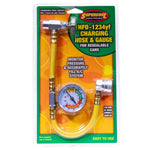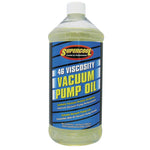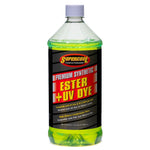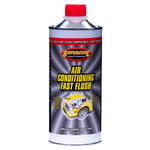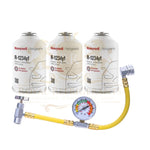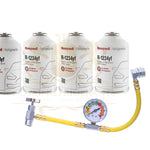You have no items in your shopping cart.

Understanding R410A operating pressures is essential for HVAC professionals and property owners alike. As one of the most common refrigerants in modern air conditioning systems, R410A operates at significantly higher pressures than its predecessors like R22. This guide explores typical pressure ranges, what affects them, how to measure them, and what to do when something goes wrong—ensuring safe, efficient, and long-lasting HVAC performance.
What Is R410A Refrigerant?
R410A is a hydrofluorocarbon (HFC) refrigerant widely used in residential and commercial HVAC systems. It replaced older refrigerants like R22 due to its improved efficiency and reduced environmental impact. Unlike R22 refrigerant, R410A has no ozone depletion potential, making it a more sustainable choice.
The Shift from R22 to R410A
The global phaseout of R22, prompted by environmental concerns, led to the widespread adoption of R410A. This newer refrigerant operates at significantly higher pressures, meaning HVAC systems had to be redesigned to accommodate the change. Understanding R410A operating pressures is critical when servicing or installing these systems.
Why Understanding R410A Operating Pressures Matters
Since R410A systems operate under high pressure, it’s crucial for technicians to use specialized tools and safety protocols. Proper knowledge of R410A operating pressures helps avoid system malfunctions, ensures energy-efficient performance, and extends the equipment’s lifespan.
What Are the Standard R410A Operating Pressures?
R410A behaves differently depending on whether the HVAC system is in cooling or heating mode. Knowing the expected pressure ranges helps technicians quickly assess system health.

Normal Pressure Ranges During Cooling Mode
In cooling mode, and at an ambient temperature around 95°F (35°C), the suction pressure—or low-side pressure—typically ranges from 115 to 140 psi. The discharge—or high-side pressure—ranges from 400 to 450 psi. These values can vary depending on humidity, coil cleanliness, and system load.
Normal Pressure Ranges During Heating Mode
When the system is in heating mode, pressures are naturally higher. Suction pressure can rise to between 200 and 280 psi, while discharge pressure may fall between 500 and 600 psi. These ranges still depend heavily on outdoor temperature and internal system conditions.
Factors That Affect R410A Operating Pressures
Understanding r410a operating pressures means considering multiple external and internal variables that can cause them to fluctuate.
Ambient Temperature and Weather Conditions
Ambient temperature plays a direct role in pressure readings. On hot days, high-side pressure will increase due to the additional heat load on the condenser. Conversely, on colder days, suction pressure will drop as refrigerant doesn't vaporize as readily. Always take ambient conditions into account when reading gauges to ensure you’re not misdiagnosing an issue.
Refrigerant Charge Level
An incorrect charge can cause abnormal R410A operating pressures. Overcharging the system will result in high suction and discharge pressures, while undercharging leads to low pressure on both sides. Regular inspections and proper refrigerant weighing can prevent these issues and keep the system running efficiently.
Tools Needed to Measure R410A Operating Pressures
Since R410A operates at higher pressures than older refrigerants, accurate and durable tools are essential for safe and effective pressure checks.

Digital Manifold Gauges
Digital manifold gauges are preferred for measuring R410A operating pressures because of their precision and ability to display both pressure and temperature data. They also often include built-in pressure-temperature charts, which are essential for calculating superheat and subcooling—two critical values in system diagnostics.
Temperature Sensors and Clamps
Using clamp-on temperature sensors on the suction and liquid lines allows technicians to cross-reference real-time temperature data with pressure readings. This is essential when trying to assess whether a system is overcharged, undercharged, or experiencing other operational problems.
Troubleshooting Abnormal R410A Pressure Readings
Abnormal pressure readings are often the first sign of system failure or inefficiency. Here's how to identify and interpret them.
High Suction and High Discharge Pressure
When both suction and discharge pressures are higher than normal, it could be due to a dirty condenser coil, which restricts airflow and forces the compressor to work harder. Another possibility is an overcharged system, where too much refrigerant has been added. This condition increases pressure throughout the system, causing inefficiency and potential component failure.
Low Suction and Low Discharge Pressure
Low pressures on both sides of the system can indicate a refrigerant undercharge, which may be caused by a leak or improper installation. Other potential culprits include a restricted metering device or a frozen evaporator coil. Either scenario will reduce the refrigerant’s ability to absorb and transfer heat, leading to subpar cooling performance.
Two More Considerations for R410A Systems
Besides pressure readings and diagnostics, there are two additional elements technicians should consider when working with R410A systems.

Safety Protocols and Equipment Ratings
Because R410A operates at high pressure, using properly rated tools and protective gear is non-negotiable. Always ensure that gauges, hoses, and recovery units are designed for high-pressure refrigerants. Wearing safety goggles and gloves is also strongly advised to prevent injuries from pressurized releases.
Environmental Regulations and Best Practices
R410A must be handled responsibly to avoid environmental damage. It’s illegal to vent this refrigerant into the atmosphere. Technicians should always recover and recycle R410A using certified recovery machines. Failing to comply with EPA regulations can result in fines and environmental harm.
FAQs
1. What is the normal suction and discharge pressure for R410A?
Suction pressure typically ranges from 115–140 psi, and discharge pressure ranges from 400–450 psi during cooling mode.
2. Why are R410A pressures higher than R22?
R410A is designed to operate at higher pressures, offering greater efficiency and requiring specialized components.
3. Can I use R22 gauges for R410A?
No. You must use tools and gauges specifically rated for high-pressure refrigerants like R410A.
4. How does temperature affect R410A pressures?
Hot temperatures increase pressure; cold temperatures lower it. Always factor in ambient conditions when reading pressure.
5. What tools are needed to check R410A pressures?
Use digital manifold gauges and temperature sensors to accurately assess and diagnose system performance.
Conclusion
Knowing and properly maintaining R410A operating pressures is a key component of safe and effective HVAC system management. Whether you're a technician troubleshooting a split system or a contractor planning a large-scale installation, getting the pressures right ensures long-term reliability and performance. At Royal Refrigerants, we offer high-quality R410A and a full range of HVAC refrigerants backed by fast shipping and expert support. Contact us for more information about R410 refrigerant and keep your systems running at peak performance.
 English
English

